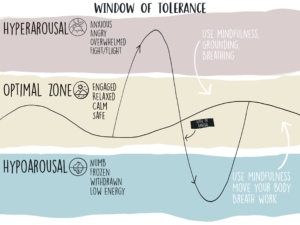Mindfulness and Compassion for Trauma Recovery
A few words about Trauma, Mindfulness and Yoga
This approach integrates practices drawing on ancient wisdom and modern science to offer a powerful path for trauma recovery. The intention is to offer these practices in safe and effective ways based on scientific research and our experience as practitioners.
There is a saying that Mindfulness itself doesn’t cause trauma yet can reveal what needs to be healed. This means when we begin to turn towards thoughts, feelings, emotions and memories we may have avoided for a long time, we may feel things that can be unpleasant. This is the mud that Thich Nhat Hanh refers to when he wrote ‘No Mud, No Lotus’. We will move gently and safely guiding you through this program.
Trauma Sensitive Mindfulness and Compassion practices help develop skills and tools to befriend and attend challenging sensations in your body where memories can be held as tension, manifesting as the stress response. Gently bringing awareness and kindness to what is arising in our present moment experience is the medicine that allows us to heal painful patterns and remember our wholeness and innate capacity for happiness. These are skills we will be developing together. They are simple and powerful yet require a commitment to practice and be present to what is arising for the duration of the program.
When we experience a traumatic event, our body, mind, and heart is impacted in a myriad of ways. Sometimes, symptoms like ongoing flashbacks, painful physical sensations, or volatile emotional reactions can emerge without warning. The body’s alarm system inside us forgets to switch off, and the imprint of trauma follows us into the present playing out in our lives again and again, challenging the perception that ‘time heals all wounds’.
Dan Siegal a professor of psychiatry at UCLA says a pot of soup is an example of integration. When we chop up the different ingredients, vegetables, chicken, herbs and add them to a broth, they harmoniously come together as a whole. Our bodies integrate our experiences when the left and right hemispheres of the brain communicate, for example the connections between thoughts and physical sensations. In relationships, integration happens when we engage in back-and-forth conversation staying connected to ourselves while attuning to others. PTSD means there is a dis-integration. Thoughts, memories, and emotions become cut off from our experience or continually flood our field of consciousness. We can find ourselves out of balance and unable to trust our senses
We aim to find the Middle Way through our experiences to be safe, using the Window of Tolerance, developed by Dan Siegal. You may like to print out the graphic of the Window of Tolerance at the end of this document, as we will be referring to this during the program.
The Window of Tolerance helps us to move through phases of healing where we develop skills and tools to become the agents of our own healing. Phase 1 involves developing a a stable base we can return to for safety. Phase 2 involves attending and befriending difficult thoughts, feelings, emotions, and sensations, including processing traumatic memories. During Phase 3 we integrate these powerful skills and tools in our relationships and in daily life.
Tips about safety and the present moment
We encourage you to be aware of your Window of Tolerance, as best you can. Sometime however, despite our good intentions, we can find ourselves moving into a state of hyperarousal or hypoarousal. We encourage you to let go of self-judgment or the need to be perfect and instead see these moments as opportunities to practice applying the new skills you are learning.
There is a body of research indicating compassion and kindness are essential qualities to cultivate in processing and integrating trauma. You may like to think of this as making an intention to be kind to yourself in the same way you would care for a good friend.
A few tips about safety and returning to the present moment. If you feel overwhelmed at any time during the practices you may like to experiment with:
– Opening your eyes and softly focusing your gaze on an object.
– Moving your body or taking a break anytime you need to.
– Feeling your body connecting with the chair, and/or feeling your feet on the ground.
– Connecting with things you can see, hear, smell and touch.
– Remembering a time you were in a safe place.
– Connecting with a memory of a person who engenders a sense of wellbeing and safety.
– Focusing on a long, slow exhalation. Breath in and count 2, then breathe out and count 4.
– Soothing Touch can help us to regulate our nervous system. Bring one hand or two hands
to your heart, or one hand on your belly and one on your heart.
– Placing your right hand under your left armpit and your left hand on your right shoulder
can support your nervous system to return to balance.
This transformative work begins with learning to attend and befriend our own experience in the moment. Through focusing on healing our own wounds, we can realise greater states of health and wellbeing, and better support those we love and care about, as well as working towards being agents of change in the larger social systems around us.
By Lisa Brown
Copyright, 2022
References
Emerson, D. and Hopper, E. (2011). Overcoming Trauma Through Yoga: Reclaiming Your
Body. North Atlantic Books.
Treleaven, D. (2018). Trauma-Sensitive Mindfulness: Practices for Safe and Transformative
Healing. Norton Publishers.

